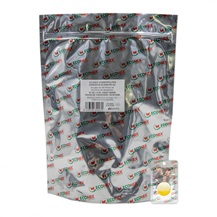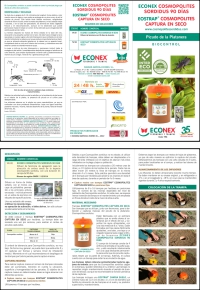Detection and monitoring
One EOSTRAP® COSMOPOLITES DRY CAPTURE TRAP should be placed per hectare. The trap should be checked once a week to count the captured weevils.
The tolerance threshold for Cosmopolites sordidusis very low. In general, it is between 5 and 10 captures per trap and per week (medium level of infestation). When this level of infestation is achieved, it is necessary
to place traps throughout the plots for mass trapping.
Mass trapping
For mass trapping, the number of traps must be increased depending on the location, surface area and homogeneity of the plots.
The aim of mass trapping in certain areas is achieved by using different options:
Mass trapping with EOSTRAP® COSMOPOLITES DRY CAPTURE TRAP in movable positions:
4 traps per hectare should be used. Owing to the fact that Cosmopolites sordidus is not a flying insect, these traps should be placed all along the infected area with the purpose of covering as much
surface area as possible, thereby reducing the pest population.
At first, the traps should be placed 20 metres apart from each other and 10 metres apart from the plot borders. The line of traps should be moved 20 metres in the same direction each month. This practice requires a density
of 4 traps per hectare to attract insects throughout the capture area for 4 or 5 months.
Mass trapping with EOSTRAP® COSMOPOLITES DRY CAPTURE TRAP in fixed positions:
8 to 16 traps per hectare should be placed in fixed positions. The number of traps depends on the population level of Cosmopolites sordidus.
In cases like this, it is required less maintenance work. This option is used in plots where labour costs are high.
Nevertheless, in both options, it is recommended to use oil to reduce the evaporation of water.
Necessary material
The trap EOSTRAP® COSMOPOLITES DRY CAPTURE TRAPand the pheromone diffusers ECONEX COSMOPOLITES SORDIDUS 90 DAYS, product authorised for use in organic farming.
The EOSTRAP® COSMOPOLITES DRY CAPTURE TRAP is used together with pheromones for the detection and mass trapping of the banana weevil: Cosmopolites sordidus.
It is made of plastic polymer which is odourless when it is heat by the sun. Also, this trap is resistant to ultraviolet rays. On average, it lasts 6 or 7 years in normal field conditions. The trap consists of three parts that
can be assembled easily: a base, a lid and a special hanger for the pheromone diffuser ECONEX COSMOPOLITES SORDIDUS 90 DAYS.
The base of the trap has 4 holes in its upper part. Also, the inside of the trap is treated with a slippery film preventing the weevil from escaping. In addition, the base has a drainage system that avoids accumulation of water.

ECONEX COSMOPOLITES SORDIDUS 90 DAYS
Kairo-feromonal attractant diffuser for the attraction of both sexes of the species Cosmopolites sordidus, with a duration of 90 days in normal field conditions.
Code: UIPHOVA181
OMDF register number (Ministry of Agriculture of Spain): 112/2014


ECONEX COSMOPOLITES SORDIDUS 90 DAYS 50 UNITS
Kairo-feromonal attractant diffuser for the attraction of both sexes of the species Cosmopolites sordidus, with a duration of 90 days in normal field conditions.
Code: UIPHOVA547
OMDF register number (Ministry of Agriculture of Spain): 112/2014


EOSTRAP® COSMOPOLITES DRY CAPTURE TRAP
Code: UIPFETA192
OMDF register number (Ministry of Agriculture of Spain): 103/2010

The trap should be placed half-buried up to the entry holes. In this way, Cosmopolites sordidus enters the trap and it remains retain. The trap does not need any maintenance work during the lifetime of the diffusers.
However, it is recommended checking the captures regularly.
The trap includes an EOSTRAP® GROUND SLEEVE, a hollow cylinder of 12.5 cm high and 11.5 cm in diameter. It facilitates the placement of the trap on the ground, monitoring and maintenance work.
The traps should be covered with remains of leaves from the banana trees because in this way the capture of the weevil is optimised. It is necessary to use a cane to point at the placed traps in order to be able to find them and
carry out maintenance work in the field.
PLACING THE TRAP
Factors that influence the number of traps needed
The pest population of Cosmopolites sordidus, bordering crops, level of control required, etc. An important factor is crop size. In small and irregular crops, a greater number of traps are required than in larger and
regular ones.
Another important factor is the distance between plots that have the same pest. In cases like this, the borders of the plots must be reinforced, so it could be necessary to place up to 16 traps per hectare or even more for
mass trapping.
Packaging difussers
ECONEX COSMOPOLITES SORDIDUS 90 DAYS
Corrugated cardboard box of 200 units (20 packs of 10 units).
Box size: 0,24 x 0,32 x 0,22 m (length x width x height) Box weight: 2,30 kg.
Number of boxes per pallet: 80.
Pallet size: 1.20 x 0.80 x 1.95 m (length
x width x height).
Pallet weight: 218 kg.

Pack of 10 units.
It includes an information
leaflet about product use.

Box of 1.250 units.
(125 packs x 10 units)
Packaging traps
EOSTRAP® COSMOPOLITES DRY CAPTURE TRAP
Corrugated cardboard box of 22 units.
Box size: 0.60 x 0.40 x 0.35 m (length x width x height).
Box weight: 8.7 kg.
Number of boxes per pallet: 20
Pallet size: 1.20 x 0.80 x 1.95 m (length x width x height).
Pallet weight: 184 kg.

Box of 22 units.
Recommended information:
ECONEX ECONEX COSMOPOLITES SORDIDUS 90 DAYS LEAFLET
Leaflet in PDF format that can be downloaded by clicking on the image.

ECONEX LEARNING CENTER
ECONEX puts at your disposal the first open knowledge center that brings together everything necessary to implement pest biocontrol in your crops. We have developed different types of resources to share with you the knowledge we have acquired during our more than 38 years of experience. Each of them is designed to respond, in the best possible way, to different questions related to pheromones, attractants, repellents and insect traps.
To access ECONEX LEARNING CENTER click on the image.























